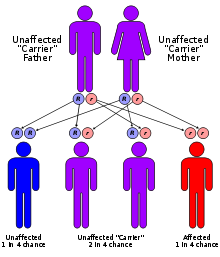- Pyruvate carboxylase deficiency
-
Pyruvate carboxylase deficiency Classification and external resources 
Oxaloacetate is the product of pyruvate carboxylaseICD-10 E74.4 ICD-9 271.8 OMIM 266150 DiseasesDB 7378 eMedicine med/1979 ped/1967 MeSH D015324 Pyruvate carboxylase deficiency is an inherited disorder that causes lactic acid and other potentially toxic compounds to accumulate in the blood. High levels of these substances can damage the body's organs and tissues, particularly in the nervous system. Pyruvate carboxylase deficiency is a rare condition, with an estimated incidence of 1 in 250,000 births worldwide. This disorder appears to be much more common in some Algonkian Indian tribes in eastern Canada.[citation needed]
Contents
Classification
Researchers have identified at least three types of pyruvate carboxylase deficiency, which are distinguished by the severity of their signs and symptoms.
Type A
Type A, which has been identified mostly in people from North America, has moderately severe symptoms that begin in infancy. Characteristic features include developmental delay and a buildup of lactic acid in the blood (lactic acidosis). Increased acidity in the blood can lead to vomiting, abdominal pain, extreme tiredness (fatigue), muscle weakness, and difficulty breathing. In some cases, episodes of lactic acidosis are triggered by an illness or periods without food. Children with pyruvate carboxylase deficiency type A typically survive only into early childhood.
Type B
Pyruvate carboxylase deficiency type B has life-threatening signs and symptoms that become apparent shortly after birth. This form of the condition has been reported mostly in Europe, particularly France. Affected infants have severe lactic acidosis, a buildup of ammonia in the blood (hyperammonemia), and liver failure. They experience neurological problems including weak muscle tone (hypotonia), abnormal movements, seizures, and coma. Infants with this form of the condition usually survive for less than 3 months after birth.
Genetics
Mutations in the PC gene cause pyruvate carboxylase deficiency. The PC gene provides instructions for making an enzyme called pyruvate carboxylase. This enzyme is active in mitochondria, which are the energy-producing centers within cells. It is involved in several important cellular functions including the generation of glucose, a simple sugar that is the body's main energy source. Pyruvate carboxylase also plays a role in the formation of the protective sheath that surrounds certain nerve cells (myelin) and the production of brain chemicals called neurotransmitters.
Mutations in the PC gene reduce the amount of pyruvate carboxylase in cells or disrupt the enzyme's activity. The missing or altered enzyme cannot carry out its essential role in generating glucose, which impairs the body's ability to make energy in mitochondria. Additionally, a loss of pyruvate carboxylase allows potentially toxic compounds such as lactic acid and ammonia to build up and damage organs and tissues. Researchers suggest that the loss of pyruvate carboxylase function in the nervous system, particularly the role of the enzyme in myelin formation and neurotransmitter production, also contributes to the neurologic features of pyruvate carboxylase deficiency.
This condition is inherited in an autosomal recessive pattern, which means two copies of the gene must be inherited for the disorder to be present. The parents of an individual with an autosomal recessive disorder are carriers of one copy of the altered gene, but do not show signs and symptoms of the disorder.
External links
See also
- Pyruvate carboxylase deficiency at NLM Genetics Home Reference
Non-Mendelian inheritance: Mitochondrial diseases (277.87) Carbohydrate metabolism PCD · PDHAPrimarily nervous system Myopathies No primary system Chromosomal Inborn error of carbohydrate metabolism: monosaccharide metabolism disorders (including glycogen storage diseases) (E73–E74, 271) Sucrose, transport
(extracellular)Disaccharide catabolismMonosaccharide transportHexose → glucose Monosaccharide catabolismGlucose ⇄ glycogen Glucose ⇄ CAC Pentose phosphate pathway Other Categories:- Autosomal recessive disorders
- Inborn errors of carbohydrate metabolism
Wikimedia Foundation. 2010.

